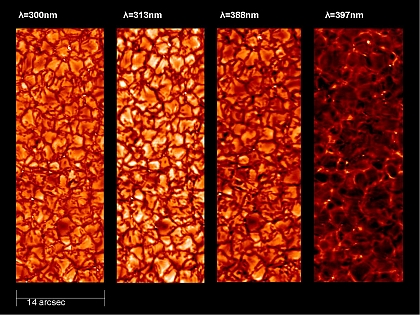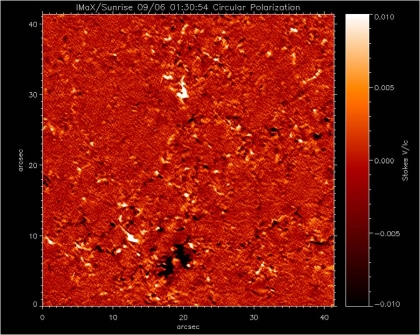Press Release 10/2009 - November 4th, 200
A bubbling ball of gas
SUNRISE telescope delivers spectacular pictures of the Sun's surface.
The Sun is a bubbling mass. Packages of gas rise and sink, lending the sun its grainy surface structure, its granulation. Dark spots appear and disappear, clouds of matter dart up - and behind the whole thing are the magnetic fields, the engines of it all. The  SUNRISE balloon-borne telescope, a collaborative project between the Max Planck Institute for Solar System Research in Katlenburg-Lindau and partners in Germany, Spain and the USA, has now delivered images that show the complex interplay on the solar surface to a level of detail never before achieved.
SUNRISE balloon-borne telescope, a collaborative project between the Max Planck Institute for Solar System Research in Katlenburg-Lindau and partners in Germany, Spain and the USA, has now delivered images that show the complex interplay on the solar surface to a level of detail never before achieved.

|
Fig. 1: Grainy sun: the images show the so-called granulation in four different wavelengths in near ultraviolet light. The image section depicts 1/20,000 of the entire surface. The smallest recognisable structures have an angular resolution equal to that of looking at a coin from a distance of 100 kilometres. The light structures are the foundational elements of the magnetic fields.
|
(Image: MPI for Solar System Research)
|
The largest solar telescope ever to have left Earth was launched from the ESRANGE Space Centre in Kiruna, northern Sweden, on June 8, 2009. The total equipment weighed in at more than six tons on launch. Carried by a gigantic helium balloon with a capacity of a million cubic metres and a diameter of around 130 metres, SUNRISE reached a cruising altitude of 37 kilometres above the Earth's surface.
The observation conditions in this layer of the atmosphere, known as the stratosphere, are similar to those in outer space: for one thing, the images are no longer affected by air turbulence; and for another, the camera can also zoom in on the Sun in ultraviolet light, which would otherwise be absorbed by the ozone layer. After separating from the balloon, SUNRISE parachuted safely down to Earth on June 14th, landing on Somerset Island, a large island in Canada's Nunavut Territory situated in the Northwest Passage, the seaway through the Arctic Ocean between the Atlantic and the Pacific.
The work of analysing the total of 1.8 terabytes of observation data recorded by the telescope during its five-day flight has only just begun. Yet the first findings already give a promising indication that the mission will bring our understanding of the Sun and its activity a great leap forward. What is particularly interesting is the connection between the strength of the magnetic field and the brightness of tiny magnetic structures. Since the magnetic field varies in an eleven-year cycle of activity, the increased presence of these foundational elements brings a rise in overall solar brightness - resulting in greater heat input to the Earth.
The variations in solar radiation are particularly pronounced in ultraviolet light. This light does not reach the surface of the Earth; the ozone layer absorbs and is warmed by it. During its flight through the stratosphere, SUNRISE carried out the first ever study of the bright magnetic structures on the solar surface in this important spectral range with a wavelength of between 200 and 400 nanometres (millionths of a millimetre).
"Thanks to its excellent optical quality, the SUFI instrument was able to depict the very small magnetic structures with high intensity contrast, while the IMaX instrument simultaneously recorded the magnetic field and the flow velocity of the hot gas in these structures and their environment", says Dr. Achim Gandorfer, project scientist for SUNRISE at the Max Planck Institute for Solar System Research.

|
Fig. 2: The IMaX instrument not only depicts the solar surface, it also makes magnetic fields visible; these appear as black or white structures in the polarised light. SUNRISE enables tiny magnetic fields on the surface of the Sun to be measured at a level of detail never before achieved.
|
(Image: MPS/IMAX consortium)
|
Previously, the observed physical processes could only be simulated with complex computer models. "Thanks to SUNRISE, these models can now be placed on a solid experimental basis", explains Prof. Manfred Schüssler, solar scientist at the MPS and co-founder of the mission.
In addition to the Max Planck Institute for Solar System Research, numerous other research facilities are also involved in the SUNRISE mission: the Kiepenheuer Institute for Solar Physics in Freiburg, the High Altitude Observatory in Boulder (Colorado), the Instituto de Astrofisica de Canarias on Tenerife, the Lockheed-Martin Solar and Astrophysics Laboratory in Palo Alto (California), NASA's Columbia Scientific Ballooning Facility and the ESRANGE Space Centre. The project is funded by the Federal Ministry of Economics through the German Aerospace Centre (DLR).
Related links
 Sunrise-Mission Homepage at MPS
Sunrise-Mission Homepage at MPS
 "SUNRISE successfully launched", MPS Press Release
"SUNRISE successfully launched", MPS Press Release
 "Reaching for the Sun ...", Article in MaxPlanckResearch
"Reaching for the Sun ...", Article in MaxPlanckResearch
 Video: surface of the Sun in close up (WMV Format, 5.1MB)
Video: surface of the Sun in close up (WMV Format, 5.1MB)
Contact
Dr. Achim Gandorfer
Max Planck Institute for Solar System Research
Max-Planck-Straße 2
37191 Katlenburg-Lindau
Tel.: 05556 979 397
Email: Gandorfer mps.mpg.de
mps.mpg.de
Dr. Peter Barthol
Max Planck Institute for Solar System Research
Max-Planck-Straße 2
37191 Katlenburg-Lindau
Tel.: 05556 979 356
Email: Barthol mps.mpg.de
mps.mpg.de
Prof. Sami K. Solanki
Director of the
Max Planck Institute for Solar System Research
Max-Planck-Straße 2
37191 Katlenburg-Lindau
Tel.: 05556 979 552
Email: Solanki mps.mpg.de
mps.mpg.de
Prof. Dr. Manfred Schüssler
Max Planck Institute for Solar System Research
Max-Planck-Straße 2
37191 Katlenburg-Lindau
Tel.: 05556 979 469
Email: Schuessler mps.mpg.de
mps.mpg.de
Dr. Norbert Krupp
Press and Public Relations
Max Planck Institute for Solar System Research
Max-Planck-Straße 2
37191 Katlenburg-Lindau
Tel.: 05556 979 154
Email: Krupp mps.mpg.de
mps.mpg.de
